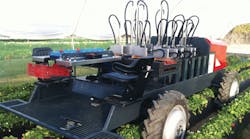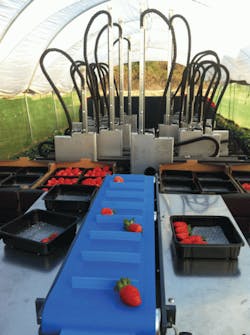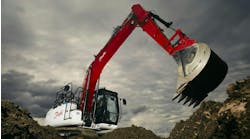When hydraulic or pneumatic lines connect to a moving machine component, there are several ways to accommodate the motion. While the easiest is to simply allow slack hose, this method can lead to excess flexing, premature hose wear, and damage from pinching or exposure to other hazards. Hose reels are another possibility, but generally they are useful only for single or dual lines and may not accommodate longer travel distances or larger hose sizes easily. Another approach that might prove better is to use a cable and hose carrier that forms a flexible shield for multiple lines, preventing them from tangling, and paying out the hose with a smooth, rolling action.
Metal-link carriers are simply parallel side links joined by crossbars that accommodate the hoses. Pivot pins and stops allow the links to travel through a predetermined arc. These designs are best for low-speed, heavy-load applications, such as machine tools.
Enclosed metal carriers are formed with small convolutions to provide better protection against chips, weld spatter, and other debris. Because carriers of this design are not limited by individual links and with their distinct travel arcs and stops, they also can operate at higher speeds, an advantage in applications such as robotics.
Where greater weight and hose-carrying capacity for longer travels are needed, nonmetallic link carriers can handle higher speeds and provide greater width and carrying capacity. This type leaves hoses open for easy inspection, but does not protect them from abrasion and debris.
Nonmetallic tube carriers are the best choice for applications that require fast travel speeds, but also require protection from outside elements. Few of the lines between parameters are clearly drawn, so it is best to begin working with a hose carrier manufacturer early in the design of any equipment with hydraulic or pneumatic lines that connect moving parts. This allows greater flexibility in choosing the hose-carrier design that provides the best combination of features for the application.
Here are some general guidelines for making a preliminary carrier selection. In terms of size, the maximum practical width for an enclosed metal tube carrier is about 6 in. Very small sizes, as well as larger sizes, are easily handled by nonmetallic designs. Nonmetal carriers are molded from fiber-reinforced plastics, which provide high strength per unit weight; however, at about one-fourth the strength of steel, these materials are not practical when combining large widths, long travels, and heavy loads.
These factors combined can help determine the final choice. For example, a low-speed application with moderate particle exposure probably calls for a metal-link design. A combination of higher speed, coupled with the presence of hot welding or grinding spatter signals the need for a metal – or specially designed heat-resistant plastic-tube type carrier. A high-speed application with the need to monitor hoses for leaks calls for an open, non-metallic design, particularly with a large number of hoses. A high-speed application that also required corrosion resistance, such as a car wash or machine with heavy coolant spray, would be a logical place for nonmetallic tube.
Ellen Rathburn is a Technical Copywriter at igus inc., East Providence, R. I. For more information, call (401) 438-2200 or visit www.igus.com.



